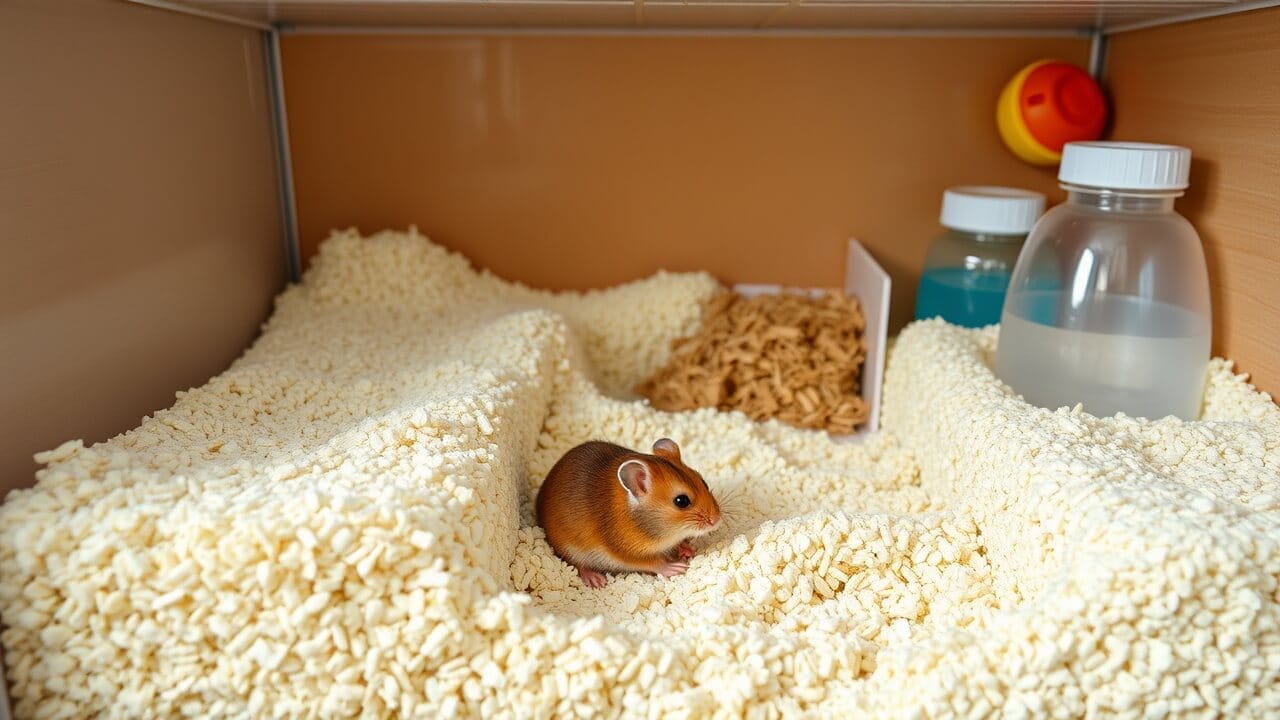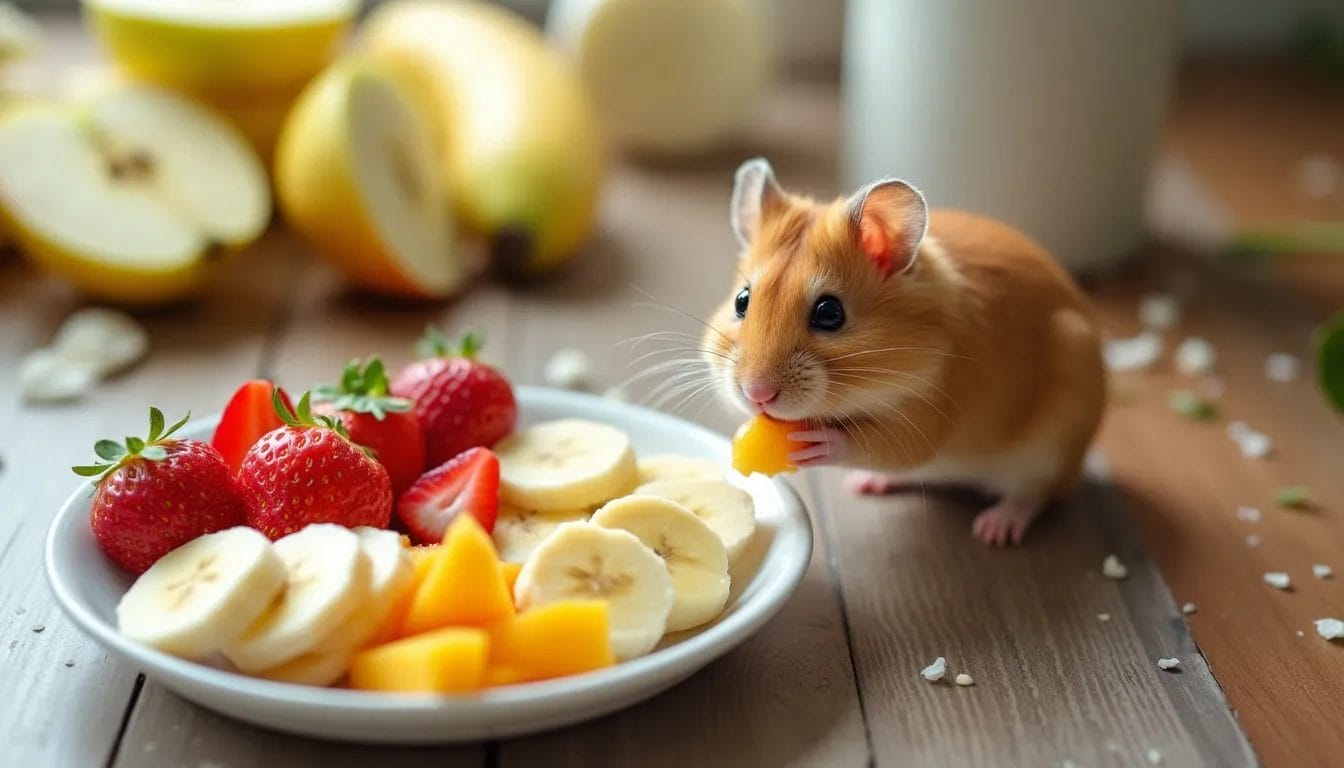
Selecting the right bedding for your hamster is crucial for its health and happiness. With several types available, it can be challenging to determine which one is best for your pet. This blog post will explore the various types of hamster bedding and the key considerations you should keep in mind when making your selection. This guide will help you make an informed decision to create a safe and comfortable environment for your furry friend.
Types of Hamster Bedding
Paper Bedding
Recycled Paper
Recycled paper bedding is a popular option among many hamster owners. It’s eco-friendly, highly absorbent, and available in various types, such as shredded, crinkled, and pellet forms. This type of bedding is often free of harmful chemicals and dyes, making it a safe option for your hamster.
Crinkle Paper
Crinkle paper bedding is another variation of paper bedding that is often highly absorbent and provides excellent odor control. Its soft and fluffy texture makes it comfortable for hamsters to nest and burrow in.
Non-Scented Paper
Non-scented paper bedding is ideal for hamsters with sensitive respiratory systems, as it is free from artificial fragrances. This type provides a dust-free environment that helps reduce the risk of respiratory issues.
Wood Shavings
Aspen Wood Shavings
Aspen wood shavings are a popular choice due to their absorbency and natural scent. Unlike pine or cedar shavings, aspen doesn’t contain harmful aromatic oils, making it a safer alternative for hamsters.
Birch Bedding
Birch bedding is another safe wood-based option. Its absorbency and low dust levels make it a great choice for maintaining a clean cage environment.
Spruce Bedding
Spruce bedding offers similar benefits to aspen and birch. It’s absorbent and has a pleasant natural smell but lacks the harmful oils found in softwood shavings.
Alternative Bedding Options

Coconut Coir Bedding
Coconut coir is an innovative bedding material derived from coconut husks. It’s highly absorbent, biodegradable, and excellent for odor control, making it an eco-friendly choice.
Cellulose Fiber Bedding
Cellulose fiber bedding is made from plant-based materials, often recycled paper products. It’s soft, absorbent, and provides a dust-free environment, which is beneficial for hamsters with respiratory sensitivities.
Hemp Bedding
Hemp bedding is natural, biodegradable, and highly absorbent. Its low dust levels and sustainability make it a popular option for environmentally-conscious hamster owners.
Corncob Bedding
Corncob bedding is made from ground corn cobs and is another natural option. However, it’s less absorbent than other types and can be prone to mold if not changed frequently.
Soft Granule Bedding
Soft granule bedding is made from recycled paper products and is designed to mimic the look and feel of natural granules. It’s soft, absorbent, and provides good odor control.
Traditional Bedding
Hay
Hay can be used as a supplemental bedding material, providing a natural environment for hamsters to burrow in. However, it lacks the absorbency of other bedding types and should be combined with a more absorbent material.
Softwood Shavings (Pine, Cedar)
Caution should be exercised when considering softwood shavings such as pine and cedar. These types can release aromatic oils that are harmful to hamsters and should generally be avoided.
Key Considerations for Choosing Hamster Bedding
Absorbency
One of the most important factors to consider is the bedding’s absorbency. A highly absorbent bedding will help keep your hamster’s cage dry, reducing the risk of respiratory issues and unpleasant odors.
Dust Levels
High dust levels can lead to respiratory problems in hamsters. It’s crucial to choose a bedding that is virtually dust-free, especially if your hamster has a sensitive respiratory system.
Odor Control
Good odor control is essential for maintaining a pleasant environment for both you and your hamster. Bedding materials that are excellent at odor control will help keep your hamster’s cage smelling fresh.
Comfort and Softness
Comfortable and soft bedding is vital for your hamster’s well-being, as it provides a cozy place to sleep and burrow. Soft materials like paper or cellulose fiber are great options for ensuring your hamster feels at ease.
Suitability for Burrowing
Hamsters love to burrow and create nests, so it’s important to choose a bedding material that supports this natural behavior. Bedding with a fluffy texture, such as crinkle paper or soft granules, is ideal for burrowing.
Safety and Non-toxicity
Ensuring your hamster’s safety is paramount. Choose bedding that is free from harmful chemicals, dyes, and aromatic oils. Avoid materials like cedar and pine shavings, which can be toxic to hamsters.
Price and Availability
The cost and availability of bedding materials can vary. Consider your budget and the frequency with which you’ll need to change the bedding. Some eco-friendly options, like recycled paper or hemp, may be more expensive but offer long-term benefits.
Environmental Impact
For eco-conscious hamster owners, the environmental impact of the bedding material is an important consideration. Biodegradable and sustainable options like coconut coir and hemp are excellent choices for reducing your carbon footprint.
Maintenance and Cleaning
Regular cleaning and maintenance of your hamster’s cage are necessary for its health. Choose a bedding material that is easy to clean and replace, ensuring that the cage remains hygienic and odor-free.
Hamster Species and Preferences
Different hamster species may have specific preferences when it comes to bedding. Observe your hamster’s behavior and note which types of bedding it seems most comfortable with. This will help you tailor the bedding choice to your hamster’s individual needs.
Weather Considerations for Bedding

Hot and Humid Climates
In hot and humid climates, it’s crucial to choose bedding that remains dry and provides good airflow to prevent infections and mold growth. Here are some suggestions:
Coconut Coir Bedding
Coconut coir is highly absorbent and has excellent odor control properties. This bedding dries quickly and reduces the likelihood of mold, making it suitable for humid conditions.
Hemp Bedding
Hemp bedding is another excellent option for hot and humid climates. It absorbs moisture well and is less likely to develop mold compared to other materials.
Recycled Paper Bedding
Recycled paper bedding is highly absorbent and helps keep the cage environment dry. Ensure to choose a non-scented, dust-free version to maintain good air quality for your hamster.
Cold Climates
In colder climates, warmth and insulation become more critical factors. Here are some bedding types that can help keep your hamster cozy:
Crinkle Paper Bedding
Crinkle paper bedding provides a fluffy and insulating layer that helps keep your hamster warm. Its soft texture is perfect for making nests that offer additional warmth.
Aspen Wood Shavings
Aspen wood shavings have good insulating properties and can help retain heat within the cage. They also provide a natural and cozy bedding environment.
Hay
While not absorbent, hay can serve as an additional insulating layer when combined with another type of bedding. It offers a natural nesting material that helps keep your hamster warm during colder months.
Best Bedding for Different Hamster Species
Different hamster species may have unique needs and preferences when it comes to bedding. Here are some suggestions to help you choose the right bedding for your particular type of hamster:
Syrian Hamsters
Syrian hamsters are one of the largest and most common pet hamsters. They are active burrowers and need bedding that supports this behavior. They also benefit from options that provide good odor control due to their size.
Recommended Bedding:
- Aspen Wood Shavings
- Crinkle Paper Bedding
- Soft Granule Bedding
Dwarf Hamsters
Dwarf hamsters, including Roborovski, Campbell’s, and Winter White hamsters, are smaller and more prone to respiratory issues. They require dust-free bedding that allows for easy burrowing.
Recommended Bedding:
- Recycled Paper Bedding
- Cellulose Fiber Bedding
- Coconut Coir Bedding
Chinese Hamsters
Chinese hamsters have a slender body and are excellent climbers and burrowers. They enjoy making intricate burrow systems, so bedding that allows for deep digging is ideal.
Recommended Bedding:
- Hemp Bedding
- Crinkle Paper Bedding
- Birch Bedding
Roborovski Hamsters
Roborovski hamsters are the smallest and most energetic of all hamster species. They need bedding that is both soft and absorbent, and that supports their burrowing habits.
Recommended Bedding:
- Recycled Paper Bedding
- Aspen Wood Shavings
- Soft Granule Bedding
Making the Right Choice
Choosing the right bedding for your hamster requires careful consideration of multiple factors. By understanding the types of bedding available and assessing the key considerations, you can make an informed decision that ensures your hamster’s safety, comfort, and happiness.
Combining Different Types of Bedding
In some cases, combining different types of bedding can offer the best of both worlds. For example, you might use a highly absorbent paper bedding as the base layer and add a softer material like hay or crinkle paper on top for burrowing. This approach allows you to maximize absorbency, odor control, and comfort, providing a well-rounded environment for your hamster.
Regular Monitoring
Once you’ve chosen the bedding for your hamster, it’s essential to monitor its cage regularly. Pay attention to any changes in your hamster’s behavior or health that might indicate an issue with the bedding. Additionally, be vigilant about cleanliness and replace the bedding as needed to maintain a fresh and healthy living space.
Conclusion
Selecting the right bedding for your hamster is fundamental to providing a happy and healthy environment for your furry friend. With numerous options available, it’s important to consider absorbency, dust levels, odor control, comfort, burrowing suitability, safety, price, environmental impact, maintenance, and your hamster’s specific preferences. Additionally, take into account the weather conditions to ensure your hamster remains comfortable throughout the year. By taking these factors into account, you can create a cozy and secure home for your hamster, ensuring it thrives and enjoys a comfortable life.
Choosing the right bedding can make all the difference in your hamster’s well-being, so take the time to explore your options and find the best solution for your pet. Your hamster will thank you with happy squeaks and energetic burrowing in its new, comfortable bedding.





